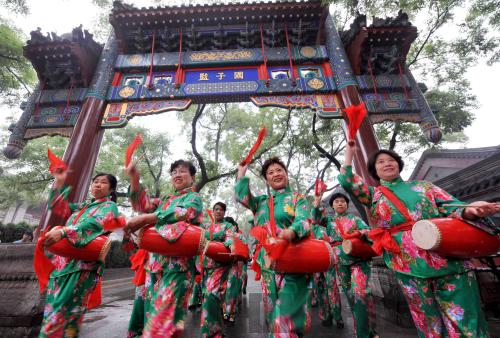|
 |
|
Guozijian Street (LUO XIAOGUANG) |
Walking out of the Yonghegong Lamasery in Beijing's Dongcheng District, which attracts lots of worshippers every day, one will find a quiet shady alley opposite the temple, called Guozijian Street, or Chengxian Street.
The 669-meter long and 11-meter wide street gradually took shape about 700 years ago. This time-honored street is well known because it houses the Confucius Temple in the east and the Imperial Academy in the west. Over the centuries, the area became one of China' most important humanist centers.
The most important architectural structure on the street is the Confucius Temple, built in the Yuan Dynasty (1271-1368). Confucius was China's great thinker and educator of ancient times, and remains a revered sage to the Chinese. Confucian temples can be found all over the country, the best known being one in Qufu (Confucius' hometown) in Shandong Province and this one on Guozijian Street. The temple is where the sacrifices to Confucius were made during the Yuan, Ming and Qing dynasties (1271-1911).
Two marble steles, about 4 meters high and 1 meter wide, stand near the east and west entrances to the temple. Both sides of the steles are inscribed in six languages, instructing that "all dismount here." Even the emperor himself had to leave his carriage and walk to the temple, acknowledging the supreme status of Confucius.
Adjacent to the temple is Guozijian or the Imperial Academy, the highest educational institution during the Yuan, Ming and Qing dynasties, combining the functions of what is now called the Ministry of Education, as well as that of a national university. During the Qing Dynasty (1644-1911), this was also where emperors frequently read Confucian classics to thousands of students.
There are old-fashioned one-storey houses on both sides of the street. A total of four archways were erected over the street. Among them, the archways that stand at the eastern and western entrances to the street bear the inscriptions of the street name. The street's four decorated archways, Chinese scholar trees, and ancient dwellings largely reflect the old Beijing.
Some old buildings are undergoing renovation while newer structures, in keeping with local design, have been restricted to a single-storey height. The street also contains a number of houses for ordinary citizens. This is still a resident community where many older men still hang out bamboo birdcages while chatting in small groups.
The street is ancient and secluded, and even the fast pace of urban life seem to slow down here. A stroll along this tranquil alley is a gentle step back in time.
Hutong Tips
How to get there
> By subway: Take subway Line 2 or Line 5 to Yonghegong Station, the street is a short walk from the stop
> By bus: Take bus 13 or 684 to Guozijian Station, or 116 or 117 to Yonghegong Station
What to buy
> At Baixingrenjia Craftwork Shop, find various kinds of folk toys made with traditional craftsmanship, ranging from Grandpa Rabbit dolls, cloth tiger, clay figurines, and other toys made of cloth, paper, clay, bamboo and wood.
Address: No.44 Guozijian Street
Where to eat and drink
> Try the delicious and healthy food at Xuxiangzhai Vegetarian Restaurant. The buffet is one of Beijing's best kept secrets.
Address: No.26-1Guozijian Street
Website: www.xuxiangzhai.com
> Liuxianguan Teahouse is an ideal place to relax and sip tea while watching the world go by. Chinese tea lectures are also available at the teahouse.
Address: No.28-1 Guozijian Street
Website: www.eatea.com
|